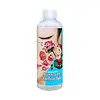What's inside
What's inside
 Key Ingredients
Key Ingredients

 Benefits
Benefits

 Concerns
Concerns

 Ingredients Side-by-side
Ingredients Side-by-side

Salix Alba Bark Water
AstringentButylene Glycol
HumectantHydroxypropyl Cyclodextrin
MaskingWater
Skin ConditioningPentylene Glycol
Skin Conditioning1,2-Hexanediol
Skin ConditioningBetaine Salicylate
AntimicrobialArginine
MaskingBetaine
HumectantPEG-60 Hydrogenated Castor Oil
EmulsifyingAllantoin
Skin ConditioningPanthenol
Skin ConditioningEthylhexylglycerin
Skin ConditioningSodium Hyaluronate
HumectantCarbomer
Emulsion StabilisingCassia Obtusifolia Seed Extract
Skin ConditioningMenthyl Lactate
MaskingMentha Haplocalix Extract
MaskingSalix Alba Bark Water, Butylene Glycol, Hydroxypropyl Cyclodextrin, Water, Pentylene Glycol, 1,2-Hexanediol, Betaine Salicylate, Arginine, Betaine, PEG-60 Hydrogenated Castor Oil, Allantoin, Panthenol, Ethylhexylglycerin, Sodium Hyaluronate, Carbomer, Cassia Obtusifolia Seed Extract, Menthyl Lactate, Mentha Haplocalix Extract
Water
Skin ConditioningLactic Acid
BufferingHelianthus Annuus Seed Oil
EmollientNiacinamide
SmoothingAlcohol
AntimicrobialGlycerin
HumectantOlea Europaea Fruit Oil
MaskingSea Cucumber Extract
Skin ConditioningZiziphus Jujuba Fruit Extract
Skin ConditioningCitrus Unshiu Peel Extract
MaskingFicus Carica Fruit Extract
HumectantApium Graveolens Extract
Skin ConditioningBrassica Oleracea Capitata Leaf Extract
Skin ConditioningOryza Sativa Extract
AbsorbentSolanum Lycopersicum Fruit Extract
AntioxidantBrassica Rapa Leaf Extract
Skin ConditioningDaucus Carota Sativa Root Extract
Skin ConditioningBrassica Oleracea Italica Extract
AstringentArgania Spinosa Kernel Oil
EmollientSimmondsia Chinensis Seed Oil
EmollientVitis Vinifera Seed Oil
EmollientSodium Hyaluronate
HumectantIllicium Verum Fruit Extract
PerfumingCitric Acid
BufferingGlycolic Acid
BufferingPEG-60 Hydrogenated Castor Oil
Emulsifying1,2-Hexanediol
Skin ConditioningButylene Glycol
HumectantCaprylyl Glycol
EmollientSodium Citrate
BufferingTrideceth-10
CleansingPanthenol
Skin ConditioningAdenosine
Skin ConditioningDisodium EDTA
Salicylic Acid
MaskingChlorphenesin
AntimicrobialParfum
MaskingWater, Lactic Acid, Helianthus Annuus Seed Oil, Niacinamide, Alcohol, Glycerin, Olea Europaea Fruit Oil, Sea Cucumber Extract, Ziziphus Jujuba Fruit Extract, Citrus Unshiu Peel Extract, Ficus Carica Fruit Extract, Apium Graveolens Extract, Brassica Oleracea Capitata Leaf Extract, Oryza Sativa Extract, Solanum Lycopersicum Fruit Extract, Brassica Rapa Leaf Extract, Daucus Carota Sativa Root Extract, Brassica Oleracea Italica Extract, Argania Spinosa Kernel Oil, Simmondsia Chinensis Seed Oil, Vitis Vinifera Seed Oil, Sodium Hyaluronate, Illicium Verum Fruit Extract, Citric Acid, Glycolic Acid, PEG-60 Hydrogenated Castor Oil, 1,2-Hexanediol, Butylene Glycol, Caprylyl Glycol, Sodium Citrate, Trideceth-10, Panthenol, Adenosine, Disodium EDTA, Salicylic Acid, Chlorphenesin, Parfum
 Reviews
Reviews

Ingredients Explained
These ingredients are found in both products.
Ingredients higher up in an ingredient list are typically present in a larger amount.
1,2-Hexanediol is a synthetic liquid and another multi-functional powerhouse.
It is a:
- Humectant, drawing moisture into the skin
- Emollient, helping to soften skin
- Solvent, dispersing and stabilizing formulas
- Preservative booster, enhancing the antimicrobial activity of other preservatives
Butylene Glycol (or BG) is used within cosmetic products for a few different reasons:
Overall, Butylene Glycol is a safe and well-rounded ingredient that works well with other ingredients.
Though this ingredient works well with most skin types, some people with sensitive skin may experience a reaction such as allergic rashes, closed comedones, or itchiness.
Learn more about Butylene GlycolPanthenol is a common ingredient that helps hydrate and soothe the skin. It is found naturally in our skin and hair.
There are two forms of panthenol: D and L.
D-panthenol is also known as dexpanthenol. Most cosmetics use dexpanthenol or a mixture of D and L-panthenol.
Panthenol is famous due to its ability to go deeper into the skin's layers. Using this ingredient has numerous pros (and no cons):
Like hyaluronic acid, panthenol is a humectant. Humectants are able to bind and hold large amounts of water to keep skin hydrated.
This ingredient works well for wound healing. It works by increasing tissue in the wound and helps close open wounds.
Once oxidized, panthenol converts to pantothenic acid. Panthothenic acid is found in all living cells.
This ingredient is also referred to as pro-vitamin B5.
Learn more about PanthenolPeg-60 Hydrogenated Castor Oil comes from hydrogenated castor oil. It is a solubilizer and emulsifier.
As a solubilizer, it helps dissolve ingredients into a water-based version. It is also an emulsifer. Emulsifier help prevent oils and water from separating. Both these properties help create evenly-spread and uniform products.
Basically, Peg-60 Hydrogenated Castor Oil helps hold ingredients together.
Learn more about PEG-60 Hydrogenated Castor OilSodium Hyaluronate is hyaluronic acid's salt form. It is commonly derived from the sodium salt of hyaluronic acid.
Like hyaluronic acid, it is great at holding water and acts as a humectant. This makes it a great skin hydrating ingredient.
Sodium Hyaluronate is naturally occurring in our bodies and is mostly found in eye fluid and joints.
These are some other common types of Hyaluronic Acid:
Learn more about Sodium HyaluronateWater. It's the most common cosmetic ingredient of all. You'll usually see it at the top of ingredient lists, meaning that it makes up the largest part of the product.
So why is it so popular? Water most often acts as a solvent - this means that it helps dissolve other ingredients into the formulation.
You'll also recognize water as that liquid we all need to stay alive. If you see this, drink a glass of water. Stay hydrated!
Learn more about Water